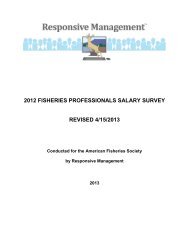Conservation Status of Crayfish Species Paddlefish Conservation ...
Conservation Status of Crayfish Species Paddlefish Conservation ...
Conservation Status of Crayfish Species Paddlefish Conservation ...
You also want an ePaper? Increase the reach of your titles
YUMPU automatically turns print PDFs into web optimized ePapers that Google loves.
intrOduCtiOn<br />
The term biodiversity has become intimately<br />
intertwined with the conservation<br />
movement <strong>of</strong> the last quarter-century, and<br />
in North America no serious discussion <strong>of</strong><br />
biodiversity and conservation can neglect<br />
the status <strong>of</strong> that continent’s freshwater<br />
fauna. The presence <strong>of</strong> a highly diverse<br />
aquatic fauna in a densely populated, economically<br />
developed country such as the<br />
United States demands the continued<br />
attention <strong>of</strong> scholars, resource managers<br />
and biologists, politicians, and private conservation<br />
groups. Current biological information<br />
for species and species groups at risk<br />
is crucial to making sound decisions on all<br />
conservation fronts.<br />
The plight <strong>of</strong> North American aquatic<br />
biodiversity, particularly invertebrate biodiversity,<br />
was brought to the forefront with<br />
the compilation <strong>of</strong> Natural Heritage / The<br />
Nature Conservancy global (g) conservation<br />
status ranks for that continent’s fauna<br />
by Master (1990). Master (1990) found a<br />
disproportionate number <strong>of</strong> aquatic organisms<br />
in need <strong>of</strong> conservation attention<br />
when compared to their terrestrial counterparts.<br />
Since then a steady stream <strong>of</strong> literature<br />
has highlighted the need for action<br />
and identified threats to the aquatic fauna<br />
(e.g., Allan and Flecker 1993; Richter et<br />
al. 1997; deWalt et al. 2005). Through<br />
the American Fisheries Society (AFS)<br />
Endangered <strong>Species</strong> Committee and others,<br />
the conservation status <strong>of</strong> North<br />
America’s freshwater fish fauna has been<br />
assessed at regular intervals (deacon et al.<br />
1979; Williams et al. 1989; Warren et al.<br />
2000) while that <strong>of</strong> other aquatic taxa such<br />
as freshwater mussels (Williams et al. 1993)<br />
and crayfishes (Taylor et al. 1996) have only<br />
recently received their first conservation<br />
reviews. With the passing <strong>of</strong> a decade since<br />
Cambarus carolinus is a burrowing species<br />
found along the margins <strong>of</strong> Appalachian<br />
streams in North carolina, South carolina, and<br />
Tennessee.<br />
photo by A. Braswell.<br />
the first, and last, conservation review <strong>of</strong><br />
North American crayfishes, the purposes <strong>of</strong><br />
this article are to (1) reassess the conservation<br />
status and threats to native crayfishes<br />
in the United States and Canada using<br />
the best information available, (2) provide<br />
updated state/provincial distributions, (3)<br />
update the list <strong>of</strong> references on the biology,<br />
conservation, and distribution <strong>of</strong> crayfishes<br />
in the United States and Canada provided<br />
in Taylor et al. (1996), and (4) assign standardized<br />
common names to those species<br />
lacking them.<br />
<strong>Crayfish</strong>es are placed in the order<br />
decapoda, which also includes crabs, lobsters,<br />
and shrimps. They are most closely<br />
related to marine lobsters (Crandall et al.<br />
2000) and differ from those organisms by<br />
possessing direct juvenile development<br />
rather than dimorphic larval stages. Also<br />
known regionally as crawfish, mudbugs,<br />
or crawdads, crayfishes are assigned to<br />
three families and are native inhabitants<br />
<strong>of</strong> freshwater ecosystems on every continent<br />
except Africa and Antarctica. Two<br />
families, Astacidae and Cambaridae, occur<br />
natively in North America and it is here<br />
that crayfishes reach their highest level <strong>of</strong><br />
diversity. Approximately 77% (405 species<br />
and subspecies) <strong>of</strong> the world’s 500+ species<br />
occur in North America (Taylor 2002),<br />
with the overwhelming majority <strong>of</strong> that<br />
continent’s fauna (99%) assigned to the<br />
family Cambaridae. With over two-thirds<br />
<strong>of</strong> its species endemic to the southeastern<br />
United States, the distribution <strong>of</strong> crayfish<br />
diversity in North America closely follows<br />
those observed in other freshwater aquatic<br />
taxa such as fishes (Warren and Burr 1994<br />
and mussels (Williams et al. 1993).<br />
<strong>Crayfish</strong>es are important ecologically<br />
as predators, bioprocessors <strong>of</strong> vegetation<br />
and carrion, and as a critical food resource<br />
for fishes and numerous other terrestrial<br />
The bottlebrush crayfish (Barbicambarus<br />
cornutus) is currently stable and found in<br />
the Green River drainage <strong>of</strong> Kentucky and<br />
Tennessee.<br />
photo by G. Schuster.<br />
and aquatic organisms (Hobbs III 1993;<br />
diStefano 2005). In some aquatic habitats<br />
they can comprise greater than 50%<br />
<strong>of</strong> macroinvertebrate biomass (Momot<br />
1995). They are equally important from<br />
an economic standpoint, supporting<br />
bait fisheries and a multi-million dollar<br />
human food fishery (Huner 2002). Finally,<br />
crayfishes in the family Cambaridae also<br />
possess unique life-history traits such as<br />
reproductive form alteration and burrowing<br />
abilities that allow numerous species<br />
to colonize seasonally wet and terrestrial<br />
habitats (Hobbs 1981; Welch and Eversole<br />
2006). Because the purpose <strong>of</strong> this article is<br />
to report on the conservation status <strong>of</strong> the<br />
North American fauna north <strong>of</strong> Mexico,<br />
we refer readers interested in the economic<br />
and ecological aspects <strong>of</strong> crayfish to previously<br />
published syntheses (Huner 1994;<br />
Taylor et al. 1996; Holdich 2002).<br />
ratiOnaLe and threatS<br />
Taylor et al. (1996) pointed to the broad<br />
disparity in the recognition <strong>of</strong> actual or<br />
potential imperilment <strong>of</strong> crayfishes between<br />
governmental agencies charged with protecting<br />
natural resources and non-pr<strong>of</strong>it<br />
conservation organizations as a rationale<br />
for their conservation assessment. At that<br />
time, only four crayfish species (Pacifastacus<br />
fortis, Cambarus aculabrum, Cambarus<br />
zophonastes, and Orconectes shoupi) received<br />
protection under the federal Endangered<br />
<strong>Species</strong> Act <strong>of</strong> 1973 (ESA) and 47 species<br />
received varying levels <strong>of</strong> protection at the<br />
state level. This was in stark contrast to the<br />
197 species listed by Master (1990) as in<br />
need <strong>of</strong> conservation attention. Taylor et<br />
al. (1996) surmised that 48% <strong>of</strong> the U.S.<br />
and Canadian crayfish fauna was imperiled.<br />
While some changes have been made<br />
at the state level (see below), the number<br />
crayfishes have historically been classified<br />
as opportunistic omnivores; however, our<br />
expanding knowledge <strong>of</strong> crayfish ecology<br />
indicates that they may be primary carnivores<br />
in some streams.<br />
photo by c. lukhaup.<br />
Fisheries • vol 32 no 8 • august 2007 • www.fisheries.org 373







